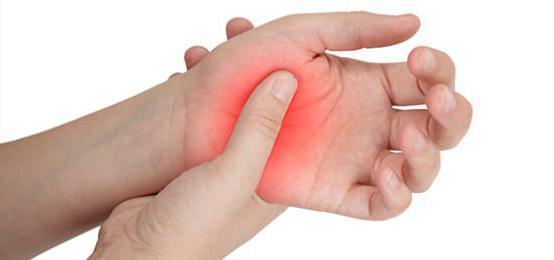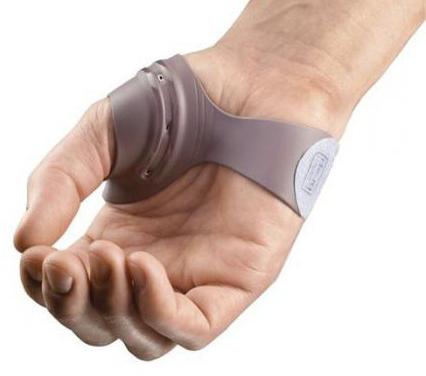Pain in the thumb: causes and treatment
If pain is felt in the thumb, then this may be a sign of dangerous diseases. Sometimes a person even has to go to the hospital, since it is simply impossible to cure some ailments at home.
Causes of pain
Pain in the thumb can occur for a variety of reasons. Doctors divide pain into 2 categories, namely inflammatory and mechanical. Pain of an inflammatory nature is characterized by prolonged stiffness of the hands, which can persist for a long time. In addition, additional symptoms may be observed, namely:
- puffiness;
- redness in the joints;
- flexibility disorder.
Mechanical pain may be accompanied by signs of local inflammation, but they are less pronounced. Often, patients simply do not notice them. There are various diseases that can cause pain in the joints of the thumbs. The reasons for this may be hidden in diseases such as:
- rheumatoid arthritis;
- psoriatic arthritis;
- gouty arthritis;
- osteoarthritis;
- Raynaud's syndrome.
In addition, gout can also provoke the onset of soreness, the cause of which is a violation of the metabolism of uric acid. With insufficient excretion of this substance from the body, it accumulates in cartilage and joints, impairing their functioning.
Causes of pain when moving fingers
Very often there is pain in the thumbs, the reasons for this can be very different. Such a violation occurs with such problems as:
- pinched nerves;
- arthrosis;
- osteoarthritis;
- tunnel syndrome.
Basically, pain occurs during flexion and extension of the fingers. If pain is often observed, and other symptoms also appear, then you need to consult a doctor for diagnosis and treatment.
The course of osteoarthritis
If pain is felt in the thumb, and small seals appear, then this may be a sign of osteoarthritis. Seals form right next to the nail. Experts call this disease knotty fingers.

In the place where the nodule is formed, there are strong painful sensations, reminiscent of burning nettles. The skin around the seal becomes reddish. The disease is mainly observed in people over 40 years of age.
Rheumatoid arthritis
Rheumatoid arthritis is considered a fairly common disease in which pain in the thumb becomes simply unbearable. If soreness is very often observed for a long time, then it is necessary to consult a doctor for additional diagnostics.
The causes of this condition can be viral or bacterial infections, colds, flu, hypothermia, overheating, stressful conditions. The risk group is mainly women, regardless of age. During the course of this disease, the fingers on the hands are very swollen, redden and numb.
Psoriatic arthritis
Pain in the joint of the thumb can occur with psoriatic arthritis. Before the joints of the fingers are affected, there is severe swelling, as well as psoriatic lesions of the skin.

During the course of this disease, the skin becomes covered with whitish scales, and a little later pain in the phalanges of the fingers, in particular, the thumb, joins. Pain in the joints can be very strong, so painkillers and anti-inflammatory drugs are required.
Gouty arthritis
With gouty arthritis, pain in the joint of the thumb is very disturbing, manifesting itself mainly at the base. Soreness and swelling can be in the toe. The pain is so severe that a person cannot even move normally and it is cutting in nature. Those affected turn red and are very sore. A person's temperature rises sharply, weakness, headache and severe fatigue appear.
Men are mostly at risk, as gout affects them more than women. This disease is characterized by sharp and severe pain, therefore, it is important to consult a doctor immediately after the onset of discomfort.
Raynaud's syndrome
Raynaud's syndrome is the most common cause of pain in the right thumb. When this disease occurs, numbness of one or more fingers is observed. If you raise your hand up, then the pain and numbness will increase even more.

A similar disease occurs mainly when carrying a child, taking hormonal and contraceptive drugs, frequent and prolonged stress, which, among other things, can also provoke arthritis.
Risk factors
There are certain factors that provoke the occurrence of pain in the thumb, which include:
- hormonal changes;
- hereditary factors;
- impaired immunity;
- infections;
- deterioration of metabolism;
- the impact of external factors;
- injury.
It is possible to determine the presence of a certain disease only if the correct therapy is prescribed by a rheumatologist or traumatologist.
Main symptoms
Pain in the right thumb can occur due to the occurrence of various diseases, which are accompanied by additional symptoms, in particular:
- the formation of nodes at the site of the joints;
- pain on pressure;
- sharp pain;
- change in the skin;
- temperature increase;
- deterioration of motor skills;
- the formation of inflammation and tumors.
Initially, you need to establish the causes that provoked discomfort and only after that, prescribe therapy.
Carrying out diagnostics
Before carrying out the treatment, it is necessary to determine exactly why the pain in the thumb of the left hand arose. Therefore, people experiencing pain in the joints and discomfort when bending the limbs require such types of diagnostics as:
- blood biochemistry;
- tomography;
- radiography;
- general analysis of urine and blood.

The occurrence of a certain discomfort when bending the fingers can be a sign of dangerous diseases. Ignoring the problem can have serious consequences. Often there is a loss of movement. As a result of this, such a problem can lead to the fact that a person cannot bend his finger, as well as provoke disability.
Features of treatment
Many diseases provoke pain in the thumb. Treatment is selected purely individually, depending on the characteristics of the course of the disease. In rheumatoid arthritis, hormonal drugs are used, in the presence of gout, drugs designed to remove urea, and in spinal lesions, it is important to eliminate the compression of nerve endings.
If symptoms of joint diseases are observed, then you should immediately seek help from a doctor. Arthritis can get worse, and soreness will only increase significantly, and well-being will worsen. Psoriasis, gout and many other pathological processes do not go away on their own and often have very serious consequences. Therefore, it is not recommended to self-medicate. Only a qualified doctor will be able to make the correct diagnosis and prescribe adequate therapy.
Medical treatment
If during the course of inflammatory processes there is pain in the joint of the thumb, treatment involves taking painkillers and non-steroidal anti-inflammatory drugs.

With significant pain, hormonal corticosteroids are used, which can be injected directly into the joint cavity. In osteoarthritis, chondroprotectors are prescribed, which provide nutrition to the cartilage tissue and help prevent the process of its destruction.
The use of folk remedies
For treatment, you can also use some traditional medicine that will complement the therapy and eliminate pain in the joints of the fingers. Well helps to cope with discomfort ointment prepared on the basis of bay leaf, juniper needles and butter. Every day you need to massage the affected fingers with the resulting remedy until the pain disappears completely.
Compresses made from fermented milk products and chalk help well. Compresses are applied at night. Boiled oatmeal is considered a similar remedy. Inside you can consume birch sap, as it contains many vitamins, as well as other useful substances that have a good effect on the joints and the entire body.
Additionally, other treatment methods can be used, in particular, such as mud therapy, physiotherapy, paraffin therapy, massage, ultrasound.
Physiotherapy
Pain in the joints of the fingers may indicate a violation of performance or certain disorders in the body. First of all, you need to abandon physical activity, as this can only aggravate the course of the inflammatory process. Physiotherapy techniques are quite effective in the fight against diseases of the joints.

These techniques include resonance therapy, electrophoresis with novocaine and electrosleep. During the period of remission, it is necessary to carry out a therapeutic effect through massage, manual therapy sessions, smearing with mud and therapeutic exercises. In addition, it is recommended to visit the sources in sanitary-resort conditions. Treatment in a sanatorium is prescribed only after a thorough examination of the patient.
Dieting
It is important to follow a special diet during therapy, which helps to cope with joint pain. It is recommended to consume fish and seafood, as the substances contained in them contribute to the normalization of mineral metabolism. Apple cider vinegar causes the excretion of salt and alkalization of the blood.
